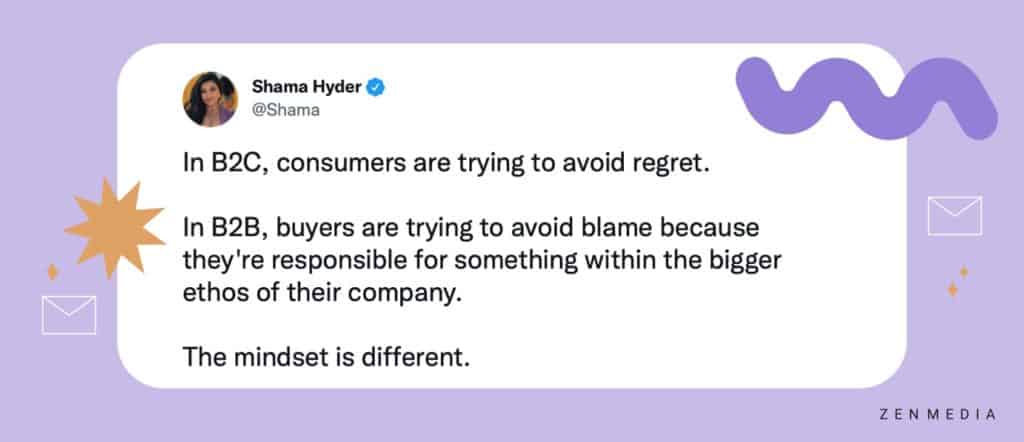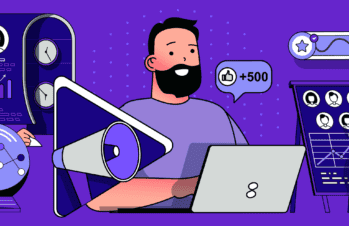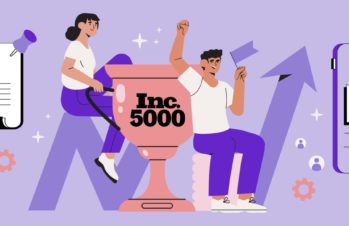The time it takes for a prospect to close and become a customer heavily depends on the product, the market, and the buyer’s readiness for your solution. But recent research shows that the average B2B customer journey takes 192 days—more than six months from the first anonymous touch to the closed deal—and in many cases, it can take much longer.
Sales cycles can be divided into three stages: top-of-funnel (awareness), middle-of-funnel (nurture), and bottom-of-funnel (close). There is also a post-close (or post-purchase) follow-up to consider. In some industries, there are far fewer touchpoint opportunities early in the pipeline than in other sectors, which heavily impacts the length of the funnel—for instance, B2B SaaS companies that have longer customer journeys (about two times as long) than B2B media companies.
In any industry, though, the B2B sales cycle is a complicated beast with many moving parts.
The three main components of sales conversion are awareness, credibility, and share of voice (every form of measurable brand awareness assets in your particular market, whether that’s an industry or a geographical region, and how those assets impact public perception). All three are interrelated and necessary, and they must be presented to the prospective buyer during their journey through the sales funnel.
During those sales stages, there are an average of 27 touch points between buyer intent and actual purchase, according to Forrester—and new research from Dreamdata suggests that the number of touchpoints is rising, with some research showing that 31 touch points may be needed to close deals now. Either way, this is a long process, and given the volatile economic climate, we are seeing more hesitation from buyers who must be able to back up every investment they make.

Thankfully, there are strategies to shorten the sales cycle—and the most effective one is public relations. PR is key to shortening that cycle because it helps brands build awareness, credibility, and share of voice.
It’s important to understand these touch points because they illustrate how much work goes into selling something and why so many businesses fail at it—the process is simply too big for most companies’ sales teams alone. The fact of the matter is, salespeople don’t make up the majority of these touchpoints—in fact, most buyers are 70% through the sales funnel before they even bother talking to a salesperson. That means that the majority of these touchpoints are made through PR and B2B marketing—and prospects coming across your brand through PR and marketing targeting strategies.
Without press placements, podcast interviews, and an online presence for prospects to come across organically—i.e., without modern PR support—most businesses would never even get off the ground as far as sales go.
Related Reading: How PR Impacts the Sales Funnel
PR builds trust.
In the early stages of a sale, trust is paramount. The buyer has to know that your company and product can provide solutions to their problems, so you need to build their confidence in every way possible. PR helps you create those touch points with your target audience via articles, interviews, and other media coverage that promote your brand’s credibility and authority on a subject matter.
Those 27 (or 31) touch points can come from relevant publications that buyers read or podcasts they listen to (earned media) but will likely also have a combination of owned media (like social posts and blogs) and paid media (like paid ads). You want a marketing mix of touchpoints, but it is proven that touch points from third parties are seen as more credible than those created by a brand itself. And remember, the more touch points a buyer has with your brand, the more likely they’ll be to continue seeing and seeking out the brand, and the better they’ll understand the brand’s offerings. And the more they know, the more trust they will have in it.
This is known as frequency bias, which works because of how our brains operate. We tend to believe things more easily if we hear them more often. People trying to sell something need to do two things:
- Get their message out there.
- Get people talking about them (share of voice).
Combining traditional PR tactics and modern sales-enabled digital PR will help your brand connect directly with prospects and potential customers at scale. That’s why we call them “touch points.” Sales cycles shorten significantly when these touch points happen more quickly in tandem with trust-building activities, such as peer endorsements or other third-party validation (including case studies).
So why don’t we just flood people with our ads until they’re sick of seeing them and finally buy something? Well, because that’s not a great strategy for building trust or increasing sales numbers in the long run. It might work in the short term (if your ad budget is unlimited). Still, it doesn’t get you any closer to actually earning someone’s business—and it may even push customers away from doing business with you altogether.
Related Reading: How PR Can Generate Revenue for Your Business
PR increases credibility.
So we know that brand awareness—i.e. frequency—leads to trust. But what about credibility? Many conflate trust and credibility as the same basic concept, but there is an important distinction.
Trust is based on character and intent.
Familiarity due to frequency gives us a certain amount of comfort, which leads us to positive perceptions of a brand’s character and intent.
Credibility is based on evidence or proof over a period of time.
So how does PR foster credibility?
The buyer’s journey through the sales funnel is messy. According to Google, buyers spend the majority of their journey exploring and evaluating in the messy middle. They’re trying to figure out what they want or need, and they don’t know where to start looking—or if they have enough information yet to make a decision at all.
The exploration phase is expansive: it involves gathering data on all of the companies they’re aware of that sell the product or service they are interested in. As they are exploring these many options, they are simultaneously evaluating them—comparing your company’s offerings against your competitors. The evaluation phase is a narrowing activity, with the buyer scratching lesser offerings off of their shortlist.
This is where credibility really matters. As you are being evaluated against your competitors, you need proof to give you the edge. Some companies achieve this by offering free samples to prove how great their products are; others rely on customer reviews—but along with these options, we recommend using PR to build credibility.
A strong PR strategy is all about third-party validation. Each press hit, where your brand is touted as a frontrunner in the industry, adds credence to your own claims because it is from a reputable (and potentially unbiased) source. Each opportunity to be positioned as a thought leader in the space further reinforces your authority and credibility as an expert.
Strong PR strategies use top-tier media, like Forbes and Inc, alongside industry-specific publications, showing readers that you are an authority in the industry and beyond. Podcast opportunities, speaking engagements, and webinars—help buyers connect with your leadership, building both trust and credibility with your audience. And beyond just touting how great your brand and leadership are, PR provides an opportunity to truly illustrate how your products or services solve problems in your industry.
To make that final leap into purchasing mode, you need prospects to see your product or service as a practical solution for their problem. Stories that draw from case studies, surveys, and reports are key for illustrating how your products are literally helping fill a gap in the marketplace—and how you can help prospects achieve real results.
Related Reading: Why B2Bs Need to Invest Big in Share of Voice
PR earns share of voice.
Share of voice (SOV) is the percentage of all impressions in the market that your brand has in comparison to your competitors. The higher your SOV, the more likely it is that you will dominate your market and be able to sell more products or services than anyone else. It is crucial to have a substantial SOV; otherwise, your brand will get lost in the noise and crossed off your prospects’ lists in favor of brands with a larger SOV.
SOV ties directly to trust in that the higher your SOV, the more likely your prospects will see and make touchpoints with your brand—creating frequency bias. If your SOV is the same as your competitors, prospects won’t be any more inclined to trust you than they are your competitors—in that case, credibility will likely be the deciding factor in their decision-making (along with finances and arbitrary subconscious biases).
On the other hand, if your competitor has plenty of evidence (case studies) illustrating their success—thereby establishing strong credibility—but has very low share of voice, their credibility likely won’t matter because:
- Buyers won’t be acutely aware of the brand, and touchpoints will take a long time—so odds are, buyers will begin favoring a different brand before they are far enough down the funnel with the highly credible but low SOV brand.
- A certain amount of credibility, like trust, is based on how others perceive brands. If a brand has amazing case studies on its website but no third-party validation, their credibility may come into question since there is no one else to validate their success and expertise.
Some may take this to mean that, in the end, SOV and trust are one and the same, and SOV is what is really needed to close sales—but this isn’t quite accurate. While SOV and trust are interrelated, you can certainly be a brand with high SOV and still not come across as trustworthy.
A brand with a high percentage of impressions in the market but messaging that comes across as inauthentic or over the top may have high SOV and even high credibility in terms of driving results for their clients but still have low trust.
Conversely, a business can come across as very trustworthy but simply not have a high enough SOV to remain top of mind for prospects, ultimately getting crossed off the list in favor of brands that are more present in prospects’ feeds and the media.
The key here is that you really do need all three to guarantee that you come out ahead of your competition. And the more you develop trust, credibility, and SOV, the shorter your sales cycles will become because all of those touchpoints will happen quickly, and you’ll be a clear frontrunner—speeding up the evaluation process and helping your prospects narrow don’t their list to one.
PR helps you get your message out to the right people at the right time, creating a stronger relationship with your audience and higher authority in the marketplace. The more prospects hear about you and experience your products and services as a result of B2B PR, the more likely they will trust you enough to buy from you—and the faster you cultivate that trust, credibility, and SOV, the faster you’ll close those sales. How are you working to shorten your sales cycle and close deals? Want to incorporate PR into your efforts but aren’t sure how? Reach out. We’d love to help.







